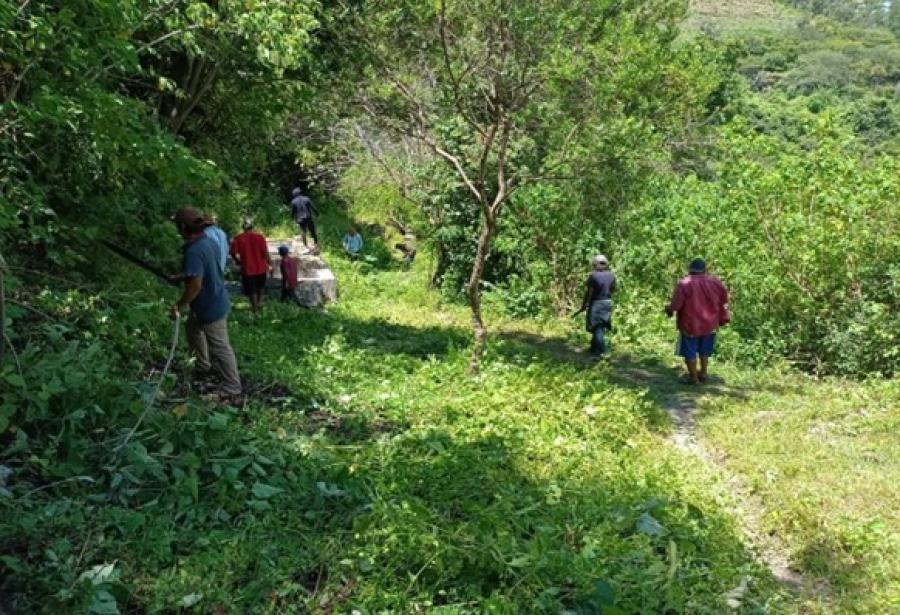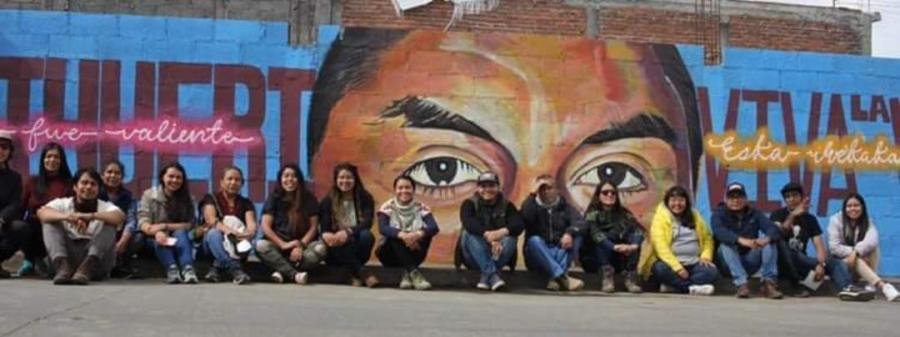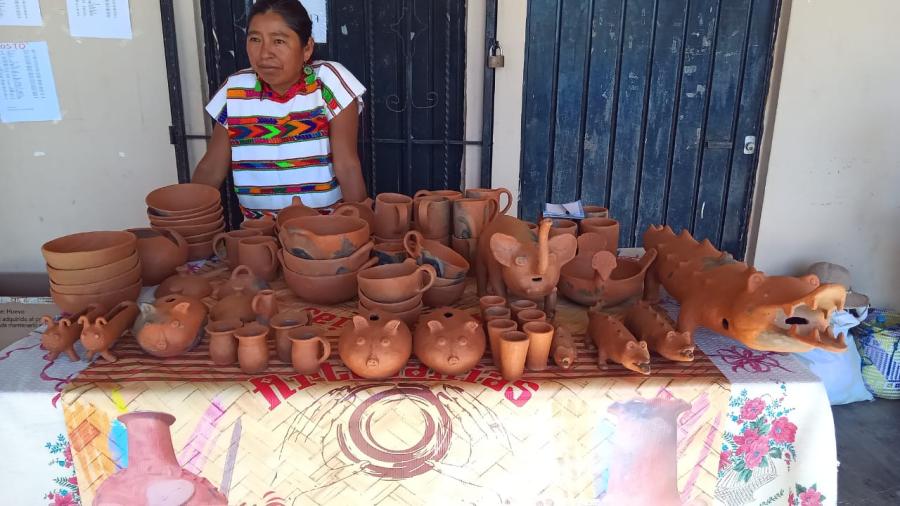From August 6 to 14, Beatriz Manz was invited by the Mexican government, as part of an America's Watch team, to discuss the situation of Guatemalan refugees with Mexican officials and to visit refugee camps in eastern Chiapas, Palenque and Campeche. This report is a description of conditions in some of the camps in eastern Chiapas where refugees agreed to the relocation as well as camps where residents refused to be moved.
Boca de Lacantun
Boca Lacantun lies at the mouth of the Lacantun River. Refugees living in the camps along the river are taken by boat to the mouth where they are then transferred to buses for the next leg of the trip to Palenque. The 200 kilometer trip to Palenque takes 7 to 8 hours by bus; No food or water is provided to the refugees while in transit.
Refugees from such areas as Benemerito travel by bus to this reception center where they join the rest of the refugees. On August 8, the only refugees in the Center were from Benemerito, all Ladinos. In Boca Lacantun 5 barracks house the refugees. COMAR is giving little food to the refugees at this center, whereas the Catholic Church, which has a large supply of food in a warehouse, is not allowed to distribute it.
A large bridge is being built at this site to extend the road that will eventually shadow the border with Guatemala.
Benemerito
Approximately 600 refugees living in Benemerito had integrated themselves into the Mexican ejido of the same name. On 8 August at 1 p.m., a Guatemalan helicopter flew over the camp which lies on the Usumacinta River, the border with Guatemala, and then landed on the Guatemalan side. Mexican residents of the area said that the day before, 18 Guatemalan soldiers had come; seven to them went as far as the road to see how the refugees were being relocated. The seven were taken by the Mexican army and the rest returned to Guatemala. The seven were later released. There was still tension about the activities of the Guatemalan army in the area. Most Mexican residents said that they were sad to see the refugees go, but that they were probably safer in Campeche.
The refugees had only been allowed to take with them what they could carry. In some cases they had been able to sell other items to Mexicans, but often they simply had to leave things behind.
Chajul
Chajul had a population of 3,150 refugees. On 11 July, COMAR began to relocate the 1520 Guatemalans who left for Campeche. More than half of the Chajul population are opposed to the move. The UNHCR insists that they want time to think about it and harvest their corn.
The refugees' houses here are well-constructed, clean and laid out in an orderly mariner. In the center of the camp, there had been a warehouse and a clinic, but both were destroyed by fire on the day that some of the camp's refugees left for Campeche. The camp also has five schoolrooms, and camp residents do the teaching.
Refugees said that they had last received food on July 7, just over one month from the time of the visit. COMAR representatives at the site insisted that this was not true, but the refugees stuck with their story. The refugees also complained that COMAR officials (in particular one Texar Gomez) had harassed them after they chose not to be relocated.
Some refugees at Chajul said that at first they had no objections to being relocated, because they were told that everything would be done voluntarily. Then the officials began to talk rough and to threaten them by saying that those who did not want to go to Campeche would be sent to Guatemala. The refugees became frightened. Some decided to go "voluntarily," others began to object to the choice they were being given. Many became suspicious about Campeche as a result of the manner in which they were given the "choice" to go. Some of the refugees reported that they were offered money and clothing or food if they went.
From the point when the refugees were presented with the choice of going to Campeche, the diocese of San Cristobal was not allowed to bring food to the camp.
According to the refugees that stayed behind, some that left went voluntarily, others under threat. COMAR representatives mentioned that some 85 chose to return to Guatemala, but the refugees who had remained behind found it impossible to believe that anyone from the camp would have chosen to return to Guatemala at this time.
The outspoken comments of the refugees at Chajul upset the COMAR representatives that were present. They claimed that the refugees were lying and that they should not be believed.
Las Cieneguitas
Las Cieneguitas, a camp south of Comitan where refugees were also opposing relocation of Campeche, was visited on 9 August with Pierre Michaelis, the UNHCR official in Comitan.
Unlike the other camps where people lived who had refused to be moved to Campeche, food was being delivered to this camp. The camp's representatives explained why they wanted to stay in their camp. They said that they wanted to remain close to Guatemala, that they had good relations with the Mexican population in the area and that they did not want to leave behind the 3000 mango and citrus trees or the corn that they had planted. They also were weaving commercially on three large looms that had been provided by the Catholic Church.
The residents were proud of their camp and their accomplishments. They pointed out adults in training to be health promoters, as well as a school and a well-stocked clinic, named "Clinica Maya Cieneguita."
Puerto Rico
Just before arriving at the Puerto Rico camp by air, one passes over Ixcan camp which appears empty. At Puerto Rico, Mexican soldiers and naval personnel as well as immigration officials question and take notes about anyone arriving at the camp. There is no camp where access to outsiders has been more restricted than this one, most likely because the charred scars of the destroyed camp attest to the reaction of the Mexican military when refugees refused to move voluntarily to Campeche. At this camp, even the COMAR and UNHCR representatives had to show their ID's because no one seemed to recognize them.
At the end of 1982, the refugees in Puerto Rico had built an airstrip with their own hands. It still looks well built and maintained, but there is no indication of the labor that had been required to cut the trees and move huge stones, all by hand. There were no refugees in sight this time. The former camp, located beside the airstrip, was not totally visible because of the vegetation, but it had clearly been destroyed.
In order to visit the 3500 refugees who did not want to be relocated to Campeche, one has to cross the wide and trecherous Lacantun River. At the river, there was no launch to ferry us across. The UNHCR was supposed to have provided both a launch and radio so that communication would always be possible in case of emergency. That day there were neither. The HCR representative then became quite upset, in no small part because he had been trying for five days to get to the new camp. He was afraid that once again he would not be able to visit it. Without a boat, a radio, or regular visits by the UNHCR protection officer, the refugees in the camp were vulnerable to attacks by Guatemalans or forced relocation by the Mexicans.
The residents of the new Puerto Rico camp had received only one shipment of food, on 4 August, since they fled to avoid what they assumed to be their forced relocation to Campeche. The refugees were anxious to speak with outsiders wanting to know of family members they had been separated from during the confusion and upheaval associated with the move to Campeche. The 883 refugees began to leave for Campeche on 30 June. According to the census, Puerto Rico had a total population of 5080 refugees. Of the refugees that left, there were 167 heads of households; 30 pregnant women; 51 with TB, 14 with Malaria, 3 epileptics and I with hepatitis. Medical personnel from Mexico's Social Service Institute checked 215 of these people, stating that the principal causes of ill health were gastroenteritis, malnutrition and 68 recorded cases of anemia. Of the 883 there were 108 children under the age of 5 and 32 people were over the age of 65.
It was amazing to see what the residents on the other side of the river, in the Lacandon forest, had been able to do in only one month. All of the people had a protected sleeping place. At the very least they had a raised wooden bed that was protected by a piece of nylon that formed a roof. Other houses were-well built with branches or large dried leaves and materials from the environment woven together to form solid walls. There were turkeys, chickens and fences. The only tools they had were machetes and axes. The residents claim that the first four days were difficult, but everyone contributed to the work teams that reconstructed their camp.
Although they had received no food during the first month at the new camp, they were able to supplement those supplies that were taken with them with edible plants (bark, tubers and fruit) from the forest.
It was not possible to visit the old burnt camp because the hanging bridge to it had been cut by the Mexican army to prevent the refugees from returning. Two military men stood guard at the site of the destroyed bridge. Once in the air, the pilot agreed to fly over the old camp. The 1000 burnt homes were a stark reminder of what the refugees had left in Guatemala. The refugees had said that they could see the smoke from the fire for three days.
La Gloria de San Caralampio
This is perhaps the most famous "dissident" refugee camp. Today it looks worse than the new Puerto Rico camp. It is enclosed with barbed wire, and the 2,800 residents are living under sheets of nylon, in part, it seems, because COMAR will not allow them to construct permanent structures. Nevertheless, the organization of the refugees is amazing.
The residents of the camp did not want to talk in front of officials, and they were organized enough to divide up the group so that they could have private conversations with us without anyone else present. Camp leaders described how refugees had left La Hamaca and La Sombra and had then formed the Chupadero camp because of attacks by the Guatemalan army. On April 30, 1984 the residents of Chupadero were attacked, reportedly by 200 Guatemalan soldiers. The entire camp fled, but, according to reports, seven people were killed in that attack. A pregnant woman had a fetus cut out of her womb, a boy was castrated and his testicles placed in his mouth. The boy's skull had been opened and the brain removed. After that attack the camp moved to Las Delicias. As the relocation program began, they moved once more to La Gloria de San Caralampio which they hoped would be their last move.
Palenque
Palenque, next to the classic Maya ruins, is the mid-transit point between the Chiapas camps and the new camps in Campeche. It was visited on 10 and 11 August. The refugees are kept in a large gymnasium until they can be accommodated in one of the warehouses in Campeche. The gym was packed; on that day there were 1,146 refugees in Palenque. Eighteen buses had been used to transport these refugees - about 63 people per bus, rather than the 40 person recommended capacity. Some people had been in Palenque for eight days. Because of the bottle-neck that was created, COMAR had to rent a warehouse to use for some of the refugees. It, too, was packed with people sleeping one next to the other on the concrete floor. By 9 pm no evening meal had been served. That night another busload of refugees arrived from Boca de Lacantun. Since there was no room for them in the gym or the warehouse, they slept outside. Some slept inside the buses in which they had arrived. The next day tarps were hung to protect the 300 to 400 people forced to live outside.
It was obvious that COMAR officials in Chiapas were taking refugees out without regard to conditions either in Palenque or Campeche. Medical personnel from the Mexican Institute of Social Security (IMSS) complained that COMAR often would notify them only 24 hours before as to which camp was going to be relocated next. That short notice, IMSS doctors felt, was insufficient to set up the infrastructure minimally adequate for maintaining health during the move.
On Saturday, 11 August, a train-load of refugees left Palenque for an all night journey to Campeche. Yet, that same night, Campeche COMAR officials were unaware of this group's impending arrival.
Article copyright Cultural Survival, Inc.




